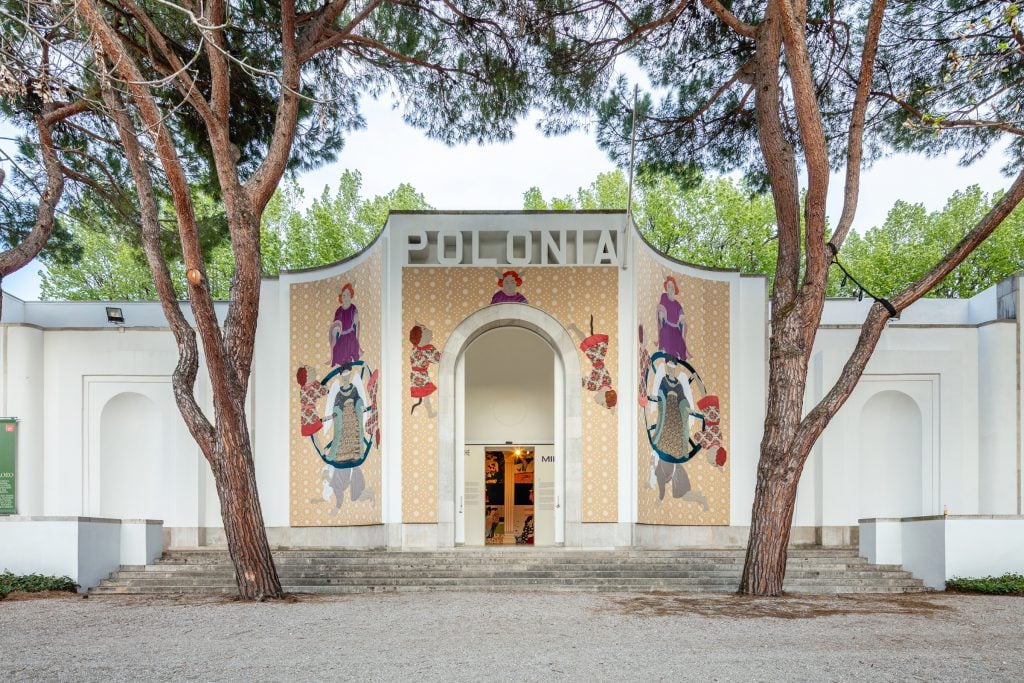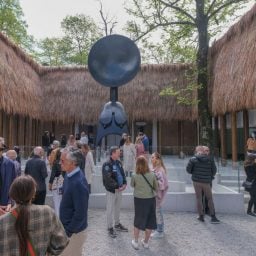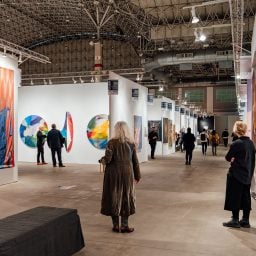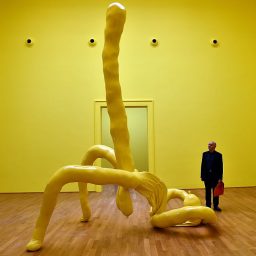After three years, the Venice Biennale has returned to Italy. In what has been described as the art-world Olympics, nations from around the globe organize presentations in a bid to gain international exposure for their artists. (The stakes can be high: The Polish pavilion, for example, receives more visitors during the first week of the Biennale than any of its museums draw all year.)
To help narrow down which pavilions deserve your closest attention, we’ve put together a guide to our nine favorites below.
Italy
Gian Maria Tosatti, “History of the Night and the Fate of Comets” curated by Eugenio Viola
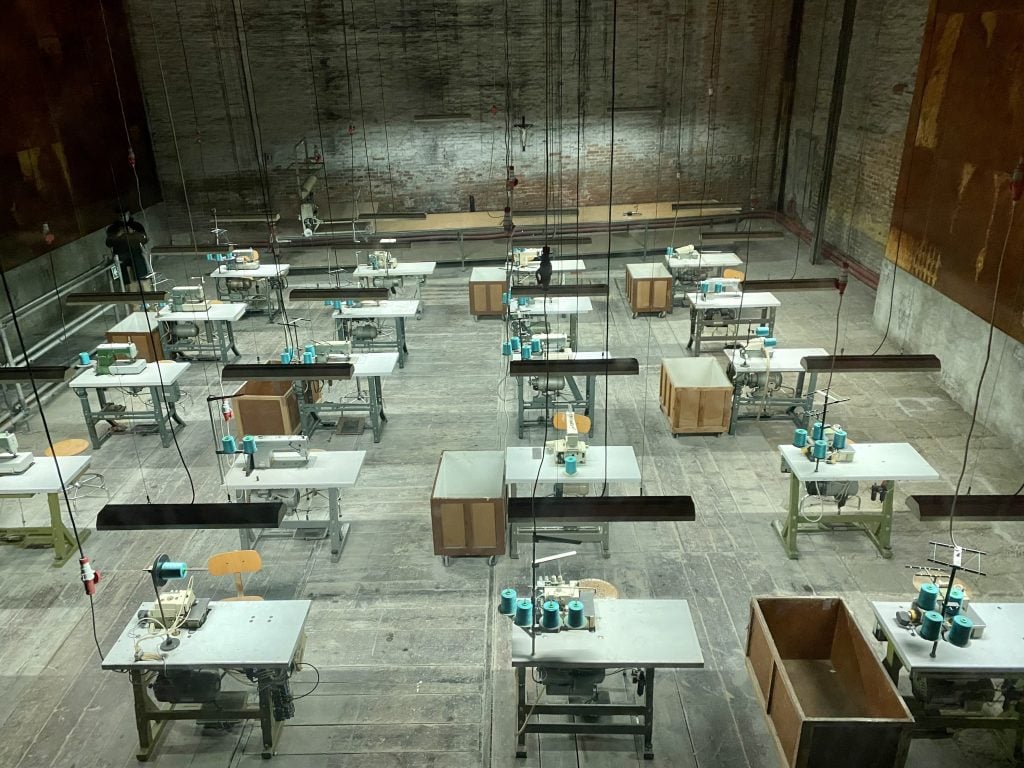
Gian Maria Tosatti’s “History of the Night and the Fate of Comets” curated by Eugenio Viola at the Italian pavilion in the Arsenale. Photo by Sarah Cascone.
The Italian pavilion in the Arsenale has been drawing long lines to see its massive installation, which takes over a 6,500-square-foot space called the Tese delle Vergini.
As the first artist ever to singlehandedly represent the country at the event, Gian Maria Tosatti has created a haunting site-specific installation that draws on Italian history and the decline of industry in the 20th century.
Visitors are asked to line up one at a time to enter the exhibition, which is filled with old machines sourced from defunct factories. You’ll encounter strange control panels, a room full of mysterious ductwork hanging from the ceiling, and a large bank of sewing machines, seemingly ready for workers to return at any moment.
Throughout, you’re asked to maintain silence, which allows the ominous quiet of the space to take full effect—especially when it’s interrupted, as by a thunderous creaking door.
The installation is imbued with a sense of dystopia, culminating with a darkened room where you can step out onto a platform above the water. Contrasting with the emptiness of the rest of the space, there are lights twinkling in the distance, suggesting that someone is out there, beyond this failed experiment.
—Sarah Cascone
Latvia
Skuja Braden, “Selling Water by
the River,” curated by Solvita Krese and Andra Silapētere
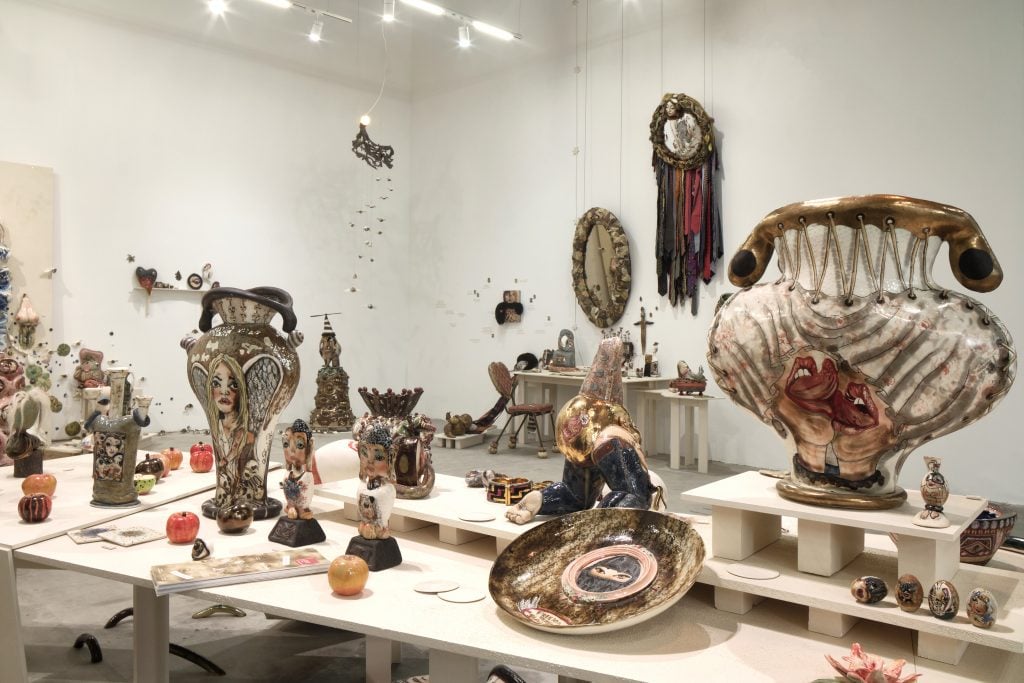
Latvian pavilion, Skuja Braden, “Selling Water by the River,” curated by Solvita Krese and Andra Silapētere, installation view at the Arsenale. Photo courtesy of the Latvia Pavilion.
Ceramics are not typically the flashiest of mediums, but artist duo Skuja Braden has created a show-stopping installation at the Latvian pavilion at the Arsenale. The more than 300 porcelain works make up for their modest scale in sheer volume, with a profusion of lovingly painted vessels piled up on tables, hanging from the walls, and even scattered across the floor.
The partners Inguna Skuja and Melissa D. Breiden have been a couple for 22 years, but cannot legally marry in Latvia, where homophobia is widespread. They’ve spoken about facing physical violence, including people throwing bags of excrement at them, making their selection a particularly progressive choice for the nation.
Their advocacy for the LGBTQ community is visible in works with erotic scenes of female lovers and a wall of bottles shaped like large, perky breasts. But there are also skulls, snails, fruits, lily pads, and many other objects represented in works that range from purely decorative to functional plates, adding a welcome element of design to the exhibition.
This is one pavilion that rewards close looking, with a plethora of tiny little details waiting to be discovered.
—Sarah Cascone
Korea
Yunchul Kim, “Gyre,” curated by Youngchul Lee

I am not typically drawn to overtly fancy “techy” art, especially when artists rely on slick surfaces and intangibility as their route to achieving some kind of sublime and holy effect. Yet I loved Yunchul Kim’s pavilion for South Korea, perhaps because it arrives at something universal and deeply spiritual by doing quite the opposite.
His presentation, “Gyre,” consists of five tactile and entanglened breathing bodies, not that there is anything human about them. The material execution of these five large kinetic sculptures is truly exquisite, and each of the machines constantly pulses and flows as they communicate with another and emanate insect sounds. The work creates a portal for contemplation on the universe and existence.
Hundreds of glass tubes flicker with light in Argos – The Swollen Suns as it picks up on the presence of subatomic particles. This triggers Chroma V, which hangs on chains in the center of the pavilion—the 164-foot-long knot of flows and moves. La Poussière de Soleils (The Dust of Suns) contains several panels of vermiculite, a kaleidoscopic material that tumbles within the panels in a pattern determined by its own sensors to light. While the other works glow with different electrical nodes, Impulse hangs quietly in some natural light near the exit, pumping Venetian seawater through its web of tubes, effectively linking these interconnecting machines with the world outside the pavilion door.
What exactly is going on between these strange, creature-like machines remains mystifying—you can only stand there as an awe-struck witness, watching it inhale and exhale as a barrier between nature and artifice collapses.
—Kate Brown
Denmark
Uffe Isolotto, “We Walked the Earth,” curated by Jacob Lillemose
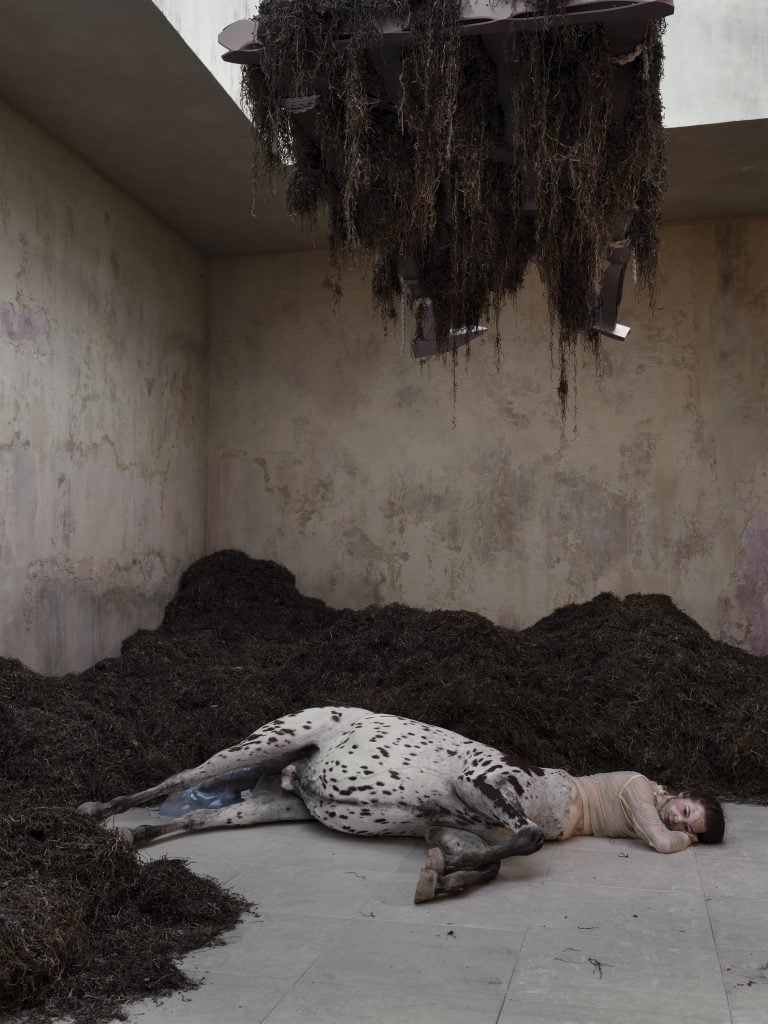
Uffe Isolotto, “We Walked the Earth.” Pavilion of Denmark, Biennale Arte, 2022. ©Ugo Carmeni.
The Danish pavilion has been transformed into a paddock for this haunting installation by Uffe Isolotto. It’s hard to get your bearings in the space, which is permeated with a faint aroma of horse manure and a hay-like substrate called eelgrass—apparently used for farmhouse roofs on the island of Læsø in Denmark. It’s populated by three skin-pricklingly hyperrealistic sculptures of a family of centaurs. In a room on the right, a female is lying on her side, giving birth to something still inside its amniotic sac. Turning away from her, your eyes land on the lower body of a male, ominously hanging from the ceiling in another room.
The space is decked out with trappings you might associate with Danish farm life but everything is just a little bit off: alien farming tools, and unfamiliar species of plants, some oozing blue fluid, are scattered around. The inconsistencies make it feel like some kind of parallel reality, but the title of the exhibition, “We Walked the Earth” suggests that the setting is not a mythical past world or alternate reality, but an imaginary post-human future.
That helpful grounding prompts the imagination to fill in the blanks as to how we might arrive from this present to that future. In a statement, Isolotto evoked the challenging realities of our present moment, whether ecological, political, or existential. “There’s much hope and despair in the air, and I want to make that a physical reality with this installation,” he wrote. Perhaps the centaurs are the descendants of humans, who have taken biotechnological efforts to adapt to survive in a changing world. There are hints that this evolution is ongoing: the creature inside the amniotic sac doesn’t quite resemble its parents, and the death of the father could symbolize the trauma and difficulty coexisting with a successive and different generation.
—Naomi Rea
Poland
Małgorzata Mirga-Tas, “Re-enchanting the World,” curated by Joanna Warsza and Wojciech Szymański
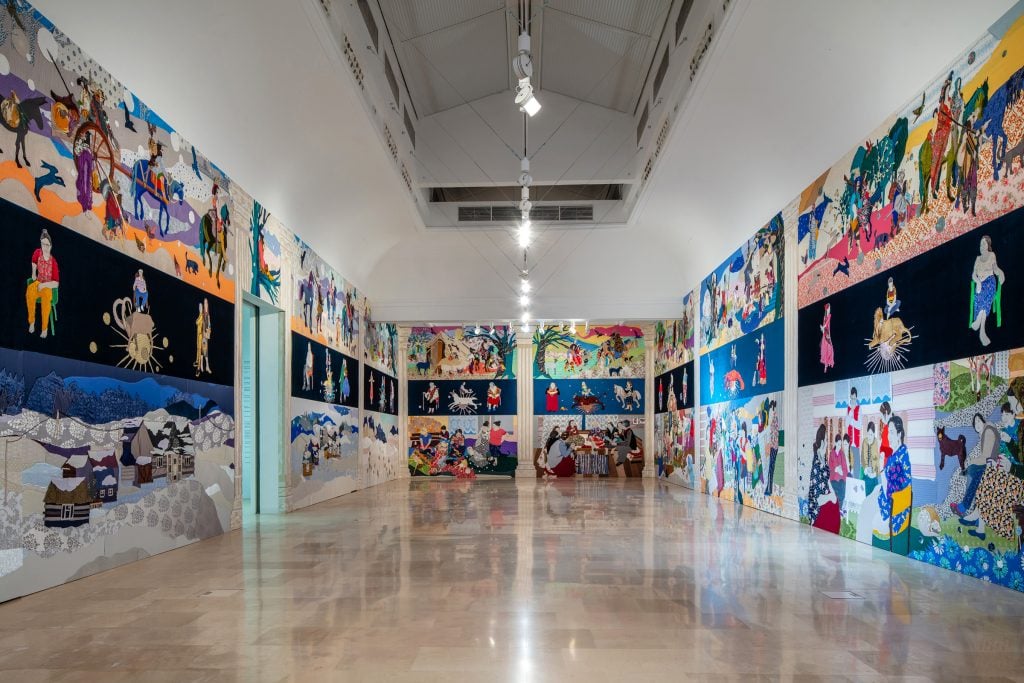
Małgorzata Mirga-Tas, Re-enchanting the World, exhibition view, Polish Pavilion at the Biennale Arte 2022. Photo: Daniel Rumiancew. Images courtesy Zachęta — National Gallery of Art.
You can’t miss the Polish pavilion. Małgorzata Mirga-Tas has covered the entire facade with hand-stitched fabric panels two stories high. Inside, the Polish-Romani artist and activist covered the walls floor-to-ceiling with three-tiered tapestries that serve as her own reinterpretation of 500-year old frescoes at Palazzo Schifanoia in Ferrara, Italy. Taking the same subject, the calendar and Zodiac, Mirga-Tas retools the imagery with a focus on the Roma people. She makes quotidian moments, like a woman hanging laundry or a family setting up camp, feel as monumental as any Renaissance church fresco. At the same time, however, she has managed to capture snapshots of a people long discriminated against with a tenderness that I didn’t know was possible in textile. The first Roma artist to represent Poland in the Biennale’s history, Mirga-Tas’s presentation is not only triumphant, but also bittersweet. In recent years, freedom of expression has been increasingly under attack in Poland as the ruling Law and Justice Party seeks to install sympathetic directors to lead its museums and shuts down shows deemed un-Christian. Let’s hope this marks the start of something new for Poland’s art world, rather than a last hurrah.
—Julia Halperin
Scotland
Alberta Whittle, “deep dive (pause) uncoiling memory,” curated by Creative Scotland
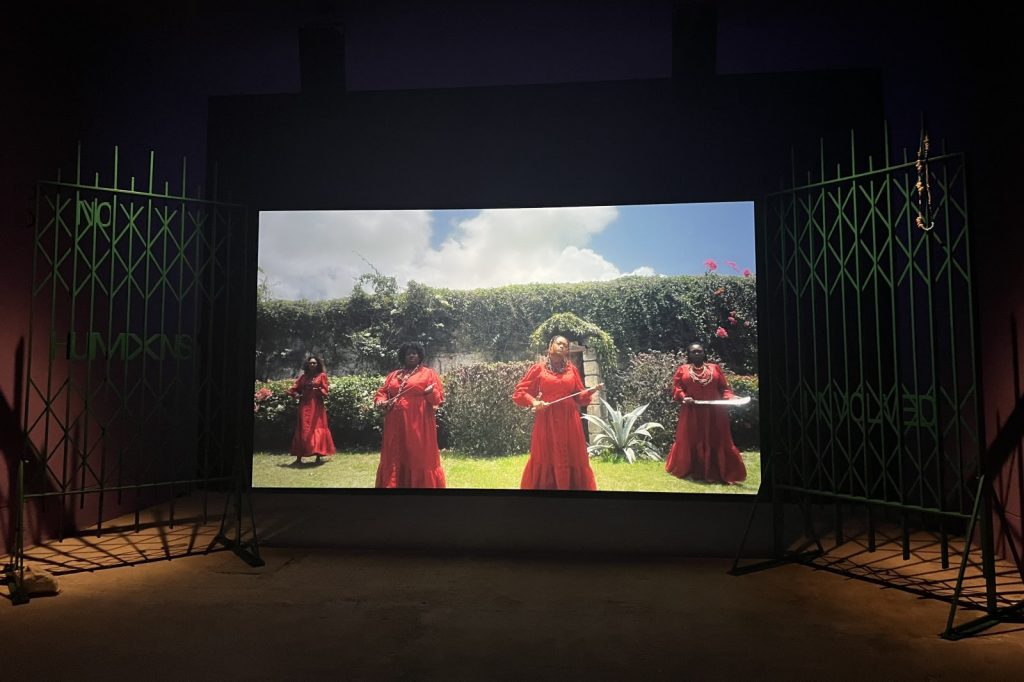
Installation view of deep dive (pause) uncoiling memory, at the Docks Cantieri Cucchini
The Scottish pavilion—just over a bridge and a few minutes’ walk from the hubbub of the Arsenale—is a slow burner. It’s not particularly flashy. But in the days after I saw it, amid a sea of other art, snapshots from the exhibition’s centerpiece, a 40-minute video called Lagareh—The Last Born, kept popping back into my head. Like the tapestry in the first gallery, Whittle’s film weaves footage of past and present together to show how our histories led to the world we live in today. I know that description sounds a little trite—but the greatness of Whittle’s film lies in just how specific it is. Shot across multiple locations in Scotland, England, Italy, Sierra Leone, and Barbados, the film includes a tour of an unmarked graveyard in Bunce Island, the site of one of the largest slave trading operations in West Africa, as well as mobile phone footage of a young Black man being arrested. There is beauty in there, too, like the lingering shots of a Black queer couple, one with their feet on the other’s lap, chatting and giggling conspiratorially over what kind of parents they plan to be and the loving home they’ll build.
—Julia Halperin
Belgium
Francis Alÿs, “The Nature of the Game,” curated by Hilde Teerlinck
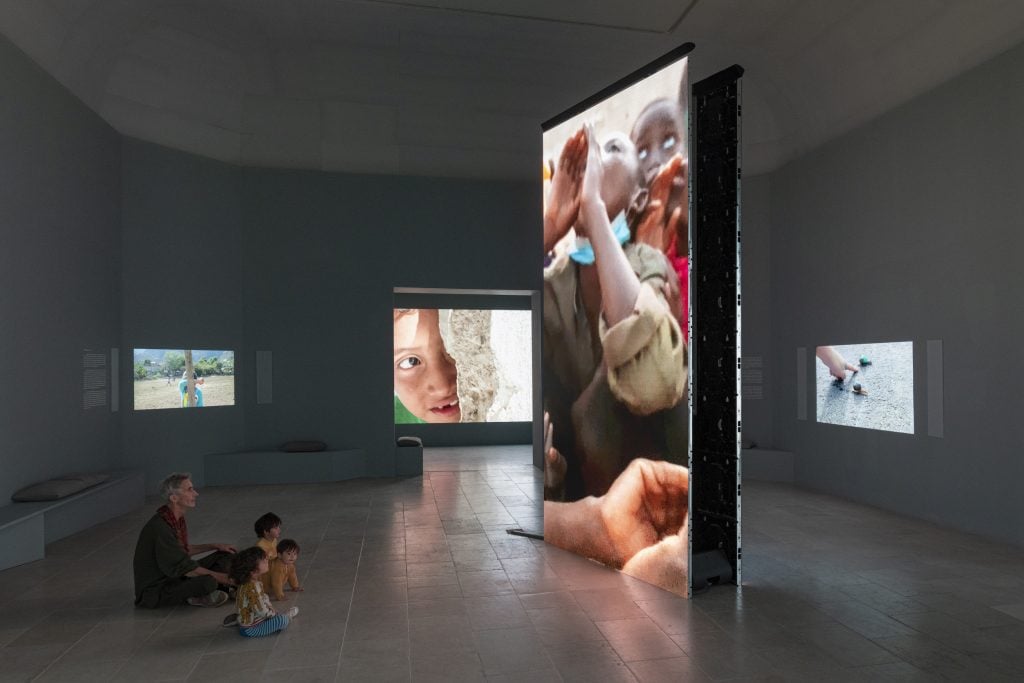
Francis Alÿs, “The Nature of the Game.” Photo: Roberto Ruiz.
It’s hard not to be moved by the Belgian artist’s installation of more than half a dozen films capturing children at play. Shot over the course of more than 20 years in Afghanistan, Belgium, Canada, DR Congo, Hong Kong, Mexico, and Switzerland, the films show children engaged in various games, united by a common focus. There’s a determined boy rolling a tire up a hill only to climb inside it to roll down; a little girl meticulously skipping over sidewalk cracks; a group of children competitively racing snails. It’s an installation that needles you to think about the Big Problems in the world—climate change, war, inequality—without mentioning them at all.
—Julia Halperin
France
Zineb Sedira, “Dreams Have No Titles,” curated by Yasmina Reggad, Sam Bardaouil, and Till Fellrath
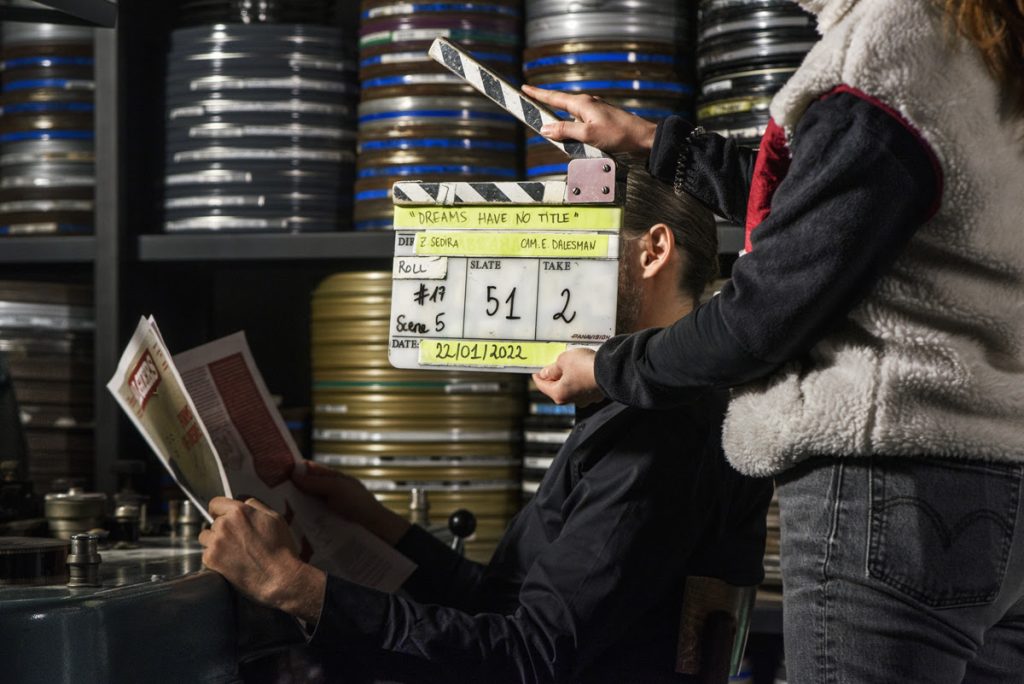
Zineb Sedira, “Dreams have no titles.” © Thierry Bal et © Zineb Sedira
Zineb Sedira is obsessed with film, and by the time you exit squinting from her walk-in film installation, you just might be, too. Sedira’s French pavilion emerged as an early favorite in the Giardini, with a long line forming as visitors waited to experience it.
The inspiration for the pavilion comes from the Algerian independence movement and the postwar films that sought to construct a cultural identity outside of French colonial representation. (Sedira is the first artist of Algerian descent to represent France.)
The entrance offers a walk-in tableau of a 1920s bar inspired by a 1983 film by Ettore Scola, enlivened by two vivacious performers who engage in a dance. In the final room, set up like an art-house movie theater, you will see the artist acting out the same part in her mesmerizing semi-autobiographical film, Dreams Have No Titles.
Themes of remaking and repetition abound, and other rooms include a stark space with a wooden coffin, which has taken Luchino Visconti’s adaptation of L’etranger by Albert Camus as its departure point, and an installation based on Sedira’s own living room at her home in London, complete with lighting rigs and stage markers. The presentation reminds viewers to embrace the possibility that life might well be a stage—and be well positioned to act on it with as much verve as the artist in her joyous performance of her own life.
—Naomi Rea
Hong Kong
Angela Su, “Arise, Hong Kong in Venice,” curated by Freya Chou and Ying Kwok
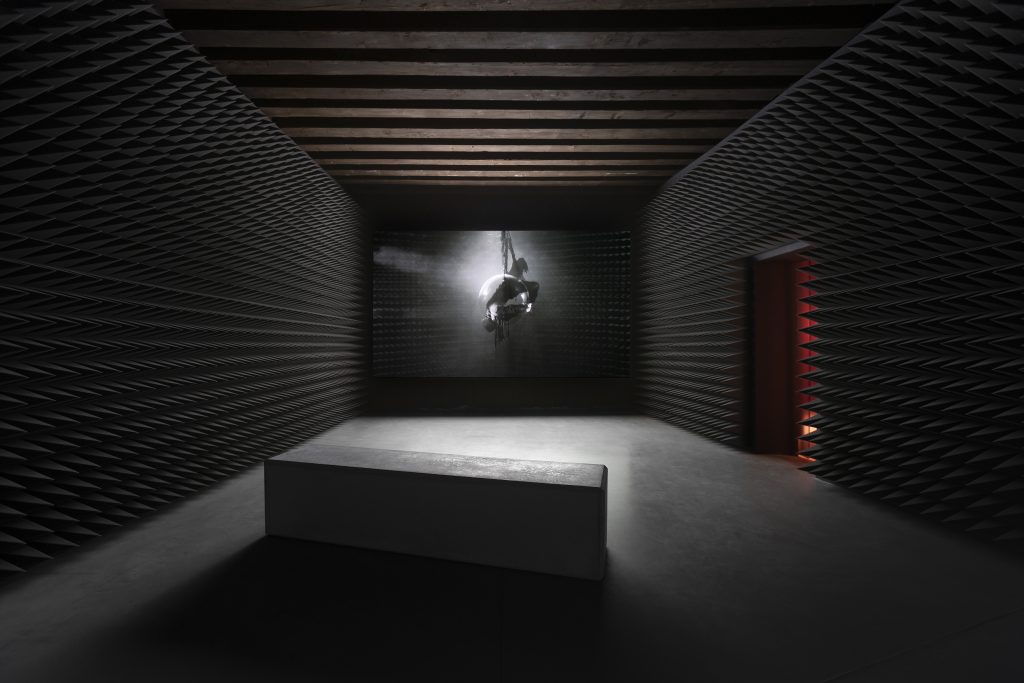
Installation view of ‘Angela Su: Arise, Hong Kong in Venice,’ 2022. Photo by t-space studio, courtesy of M+, Hong Kong.
Co-presented by Hong Kong’s M+ museum and the Arts Development Council, homegrown artist Angela Su’s solo presentation, “Arise, Hong Kong in Venice,” is the first Hong Kong show (a collateral event of Venice Biennale) since the M+ finally opened last year, and it did not disappoint.
The layered exhibition, curated by Freya Chou in collaboration with consulting curator Ying Kwok, takes viewers on a journey through Su’s artistic practice and the precarious times we are living in. Upon entering the space, located just outside the entrance to the Arsenale, is a courtyard of sculptural pieces drawing on found or fictitious footage of circus performances, which are featured in a set of video installations.
Walking further into the space, viewers are confronted with Su’s meticulous drawings and hair embroidery that cast an eerie eye on human and animal anatomy. Viewers are then led to the show’s centerpiece, a pseudo-documentary called The Magnificent Levitation Act of Lauren O. Set against the backdrop of the U.S. anti-war movement of the 1960s, the video work is a powerful piece, a nearly seamless blending of fiction and fact, that questions the way humans are dealing with our present hyper-politicized realities.
—Vivienne Chow
